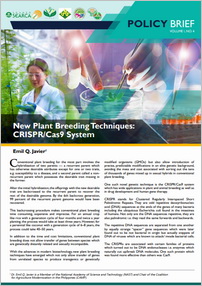
Scientist Expounds on Process and Benefits of CRISPR-Cas9 System in SEARCA BIC Policy Brief
February 27, 2019| |
 Conventional plant breeding using the backcrossing technique can be laborious, expensive, and imprecise. In addition to time and cost limitations, it does not allow transfer of genes between species which are genetically distantly related and sexually incompatible.
Conventional plant breeding using the backcrossing technique can be laborious, expensive, and imprecise. In addition to time and cost limitations, it does not allow transfer of genes between species which are genetically distantly related and sexually incompatible.
With the advances in modern technology, new plant breeding techniques have emerged which not only allow transfer of genes from unrelated species to produce genetically modified organisms (GMOs) but also allow precise and predictable genetic modifications, avoiding the cost and complications associated with sorting through a myriad of genes in conventional plant breeding.
In SEARCA Biotechnology Information Center's (SEARCA BIC) fourth Policy Brief, Dr. Emil Q. Javier, a member of the National Academy of Science and Technology (NAST) and Chair of the Coalition for Agriculture Modernization in the Philippines, Inc. (CAMP), expounds on the CRISPR-Cas9 System, a novel genetic technique which has wide applications in plant and animal breeding as well as in drug development and human gene therapy. CRISPR, which stands for Clustered Regularly Interspaced Short Palindromic Repeats, is a natural immune defense system found in lower forms of organisms like bacteria and has been tweaked to work in higher plants and animals including man as a precise, relatively quick and affordable method of genome editing.
The 2018 Policy Brief series is produced in partnership with the International Service for the Acquisition of Agri-biotech Applications (ISAAA), Coalition for Agriculture Modernization in the Philippines (CAMP), Department of Agriculture-Biotechnology Program Office (DA-BPO), Program for Biosafety Systems (PBS), and DA-Bureau of Agricultural Research (DA-BAR). For more details, read the full policy brief.
| |
Biotech Updates is a weekly newsletter of ISAAA, a not-for-profit organization. It is distributed for free to over 22,000 subscribers worldwide to inform them about the key developments in biosciences, especially in biotechnology. Your support will help us in our mission to feed the world with knowledge. You can help by donating as little as $10.
-
See more articles:
-
News from Around the World
- FAO Report: Biodiversity Vital for Food and Agriculture Declining Fast
- USDA FAS Releases Report on Agri-biotech Status of South Africa
- Scientists Develop Wheat that Fights Celiac Disease
- US Ag Secretary Perdue: "Don't Fear Your Food"
- Isabela Governor: "Golden Rice is a Responsible Research"
- Independent Review Finds GM Crop Moratorium in South Australia Costing Farmers Millions
- Researchers Discover How Cell Walls are Assembled
-
Research Highlights
- Overexpression of Maize Gene Enhances Salt and Drought Tolerance in Transgenic Tobacco
- Scientists Develop Method for Regeneration and Transformation of Groundcherry
-
Announcements
- International Conference on Plant Breeding for Sustainable Development
-
Resources
- Infographics: How Crops are Genetically Modified
- 5 Questions with Dr. CD Mayee, the Farmer's Son Who Became India's Champion of Biotech
-
Plant
- CRISPR-Cas9 Used to Develop Lignin-enriched Rice
- Scientist Expounds on Process and Benefits of CRISPR-Cas9 System in SEARCA BIC Policy Brief
- CRISPR-Cas9-mediated Editing Reveals a Major Role of a SUMO Protease in Rice Salt Tolerance
-
Read the latest: - Biotech Updates (April 17, 2024)
- Gene Editing Supplement (April 10, 2024)
- Gene Drive Supplement (February 22, 2023)
-
Subscribe to BU: - Share
- Tweet
